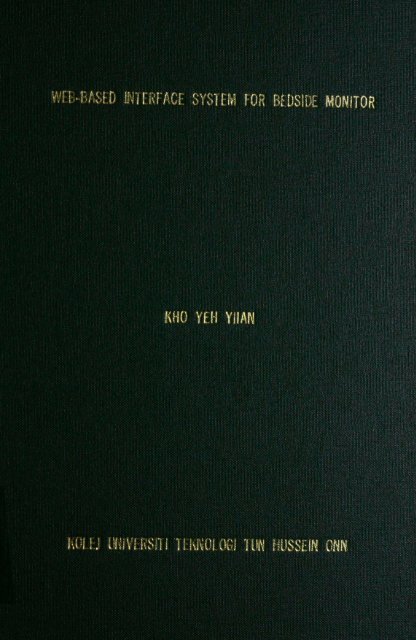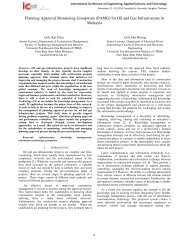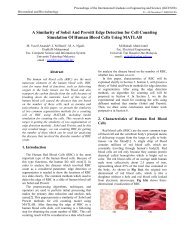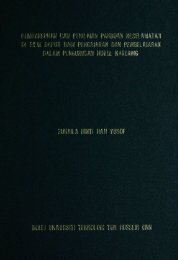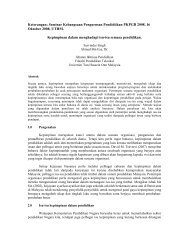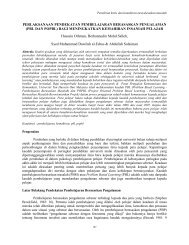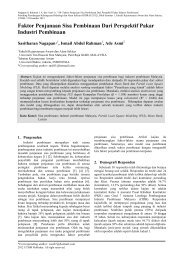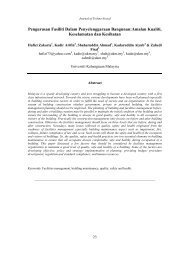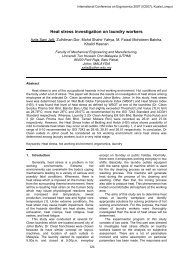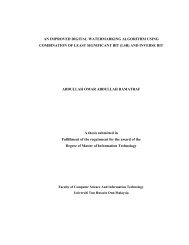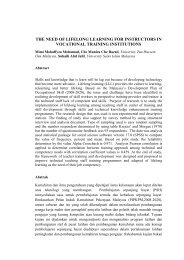borang pengesahan status tesis
borang pengesahan status tesis
borang pengesahan status tesis
You also want an ePaper? Increase the reach of your titles
YUMPU automatically turns print PDFs into web optimized ePapers that Google loves.
KHO YEH YUAN<br />
IUHJ llliVlifSni liKROIOSi nw HUSSEW OWN
^ ^ S P H S ^ r "
KOLEJ UNIVERSITI TEKNOLOGI TUN HUSSEIN ONN<br />
BORANG PENGESAHAN STATUS TESIS*<br />
JUDUL: WEB-BASED INTERFACE SYSTEM FOR BEDSIDE MONITOR<br />
SESI PENGAJIAN: 2004/2005<br />
Saya KHO YEH YIIAN<br />
(HURUF BESAR)<br />
mengaku membenarkan <strong>tesis</strong> (PSM/Saij ana/Doktor Falsafah)* ini disimpan di Perpustakaan<br />
dengan syarat-syarat kegunaan seperti berikut:<br />
1.<br />
2.<br />
3.<br />
4.<br />
Tesis adalah hakmilik Kolej Universiti Teknologi Tun Hussein Onn.<br />
Perpustakaan dibenarkan membuat salinan untuk tujuan pengajian sahaja.<br />
Perpustakaan dibenarkan membuat salinan <strong>tesis</strong> ini sabagai pertukaran antara institusi<br />
pengajian tinggi.<br />
**Sila tandakan {/)<br />
1 | SULIT (Mengandungi maklumat yang berdaijah keselamatan atau<br />
kepentingan Malaysia seperti yang termaktub di dalam<br />
(AKTA RAHSIA RASMI 1972)<br />
| | TERHAD (Mengandungi maklumat TERHAD yang telah ditentukan<br />
oleh organisasi/badan di mana penyelidikan dijalankan)<br />
1 V 1 TIDAK TERHAD<br />
(TANDATANGA^ PENULIS)<br />
Alamat tetap:<br />
18. PERSIARAN 16.<br />
PERSIARAN BROOKE,<br />
96000 SIBU.<br />
SARAWAK.<br />
Disahkan oleh<br />
(TANDAT/ik(MN PENYELIA)<br />
PROF DR HASHIM BIN SAIM<br />
Nama Penyelia<br />
Tarikh: 28 MAC 2005 Tarikh: 28 MAC 2005<br />
CATATAN: * Potong yang tidak berkenaan.<br />
** Jika <strong>tesis</strong> ini SULIT atau TERHAD, sila lampirkan surat daripada pihak<br />
berkuasa/organisasi berkenaan dengan menyatakan sekali sebab dan<br />
tempoh <strong>tesis</strong> ini perlu dikelaskan sebagai SULIT atau TERHAD.<br />
• Tesis dimaksudkan sebagai <strong>tesis</strong> bagi Ijazah Doktor Falsafah dan<br />
Saijana secara penyelidikan, atau disertasi bagi pengajian secara keija<br />
kursus dan penyelidikan, atau Laporan Projek Saijana Muda (PSM).
"Saya/Kami akui bahawa saya/kami telah membaca karya ini dan pada pandangan<br />
saya/kami karya ini adalah memadai dari segi skop dan kualiti untuk tujuan<br />
pengaugerahan Ijazah Saijana Kejuruteraan (Elektrikal)."<br />
Tandatangan<br />
Nama Penyelia I<br />
Tarikh<br />
Tandatangan<br />
Nama Penyelia II<br />
Tarikh<br />
Profesor Dr. HWhim Bin Saim<br />
28 Mac 2005<br />
Soon Chin Fhong<br />
28 Mac 2005
WEB-BASED INTERFACE SYSTEM FOR<br />
BEDSIDE MONITOR<br />
KHO YEH YUAN<br />
A thesis submitted<br />
in fulfillment of the requirements for the award of the<br />
Degree of Master of Engineering (Electrical)<br />
Faculty of Electrical and Electronic Engineering<br />
Kolej Universiti Teknologi Tun Hussein Onn<br />
MARCH, 2005
"No part of the study was covered by copyright. References of information obtained<br />
from other source are specially quoted, otherwise the rest of the information<br />
presented through this study is the sole work and experimentation carried out by the<br />
Signature<br />
Author<br />
Date<br />
author"<br />
KHO YEH YTDLAN<br />
28 March 2005
for my beloved parents, brothers and Chee Kiong, may God shower uncountable<br />
blessings upon all of you
ACKNOWLEDGEMENT<br />
I would like to express my sincere gratitude to Prof. Dr Hashim bin Saim, my<br />
supervisor and Mdm Soon Chin Fhong, my co-supervisor for their invaluable<br />
guidance and advice throughout this research and all of my work with them and for<br />
helping to move this process forward as quickly as possible. I would like to thank<br />
Mr. Tang Tung Yan for providing input and advices. My parents have always been a<br />
great source of encouragement in believing that I can accomplish whatever I want.<br />
For my beloved late brother Yeh Wei, I would also like to thank you for everything.<br />
I would like to take this opportunity to thank also my husband, Mr Sia Chee<br />
Kiong for his patience with me all this while. In addition, I would like to thank<br />
others who have indirectly contributed to the completion of this research such as the<br />
medical laboratory technician, Mr. Ahyat for providing help whenever I needed to.<br />
And also to all my friends, a big thank you to all of you for being my "patients".<br />
There are also many other people that have provided me help and support and one<br />
time or another that I should also thank, but the list would grow too long.<br />
Many thanks and good luck to everyone.
ABSTRACT<br />
From face-to-face consultation to medicine at a distance, technology is<br />
changing the way medical services are delivered to the people. We are going into an<br />
era where the information is being digitized to be stored in a database. This is done<br />
in order to reduce information overlap and redundancy that are the main problems<br />
the health care sector are facing right now. More hospitals in other more advanced<br />
countries are going paperless. In order to provide better services to the critically ill<br />
patients in the ICU or CCU, a data acquisition program is developed for the<br />
acquisition of vital signs monitored in the critical care units. This work discusses the<br />
work done in extracting the data and signal from patient monitor BSM 8800 to the<br />
computer. The data are acquired using RS232C Interface Protocol. The vital signs<br />
acquired include oxygen saturation (SaCh), heart rate (HR), electrocardiograph<br />
(ECG) signal, non-invasive blood pressure (NIBP), respiration rate (RR),<br />
temperature (TEMP) and end tidal carbon dioxide (PETCO2 or ETCO2). Ventricular<br />
Premature Contraction (VPC), ST level and arrhythmia information are also acquired<br />
and displayed to provide a more thorough information on the condition of the<br />
patients. Alarm detection is also programmed so that in critical conditions the vital<br />
signs will be displayed in red for extra caution. An ECG user control is designed<br />
and embedded in the web page in order to convert and plot the ECG waveform from<br />
hexadecimal values sent from the bedside monitor. The user control has been tested<br />
its accuracy and proved its validity to reconstruct the original ECG waveform. Basic<br />
patient information can also be seen from the graphical user interface (GUI) that has<br />
been developed. Physicians and medical practitioners have to register with the<br />
system before gaining access to the system and only the physician-in-charge of the<br />
patient can see the more intricate details of the patient.
ABSTRAK<br />
Teknologi sedang mengubah cara peijumpaan pesakit dengan doktor secara<br />
konvensional kepada cara rawatan dari lokasi lain sedikit demi sedikit. Kita sedang<br />
menuju ke era di mana maklumat ditukar kepada bentuk digital untuk disimpan<br />
dalam pangkalan data. Ini adalah bertujuan mengurangkan informasi dan maklumat<br />
yang sama difailkan dua kali. Sektor perubatan kini sedang menghadapi masalah<br />
perlapisan data serta data lapuk yang tidak dikemaskinikan. Hospital di negara-<br />
negara maju telahpun lama mengaplikasikan cara penyimpanan rekod secara digital<br />
untuk mengelakkan pembaziran kertas. Bagi memberikan rawatan yang lebih baik<br />
kepada pesakit-pesakit di unit-unit kecemasan, satu program untuk mendapatkan<br />
data pesakit untuk pemeriksaan doktor dan jururawat dibangunkan. Tesis ini<br />
membincangkan keija yang dibuat untuk mendapatkan data tersebut daripada BSM<br />
8800 kepada komputer. Data didapatkan melalui protokol RS232C yang<br />
membolehkan komunikasi antara alatan dengan komputer. Data yang didapatkan<br />
termasuk kepekatan oksigen (Sa02 atau Sp02), kadar denyutan (HR),<br />
elektrocardiograf (ECG), tekanan darah (NIBP), kadar respirasi (RR), suhu badan<br />
(TEMP) dan kepekatan karbon dioksida dalam darah (ETC02 atau PETC02).<br />
Kontraksi ventrikel awalan (VPC), tahap ST dan maklumat mengenai ECG yang<br />
tidak normal turut didapatkan bagi mengetahui keadaan pesakit yang lebih<br />
menyeluruh. Di kala teijadinya kecemasan, data akan terpapar dalam warna merah.<br />
Satu program bagi menukarkan maklumat dalam bentuk heksa kepada voltan ECG<br />
yang sepatutnya dibangunkan. Ia diuji dalam ketepatannya dan terbukti bahawa<br />
ianya boleh dipercayai untuk menghasilkan gelombang ECG yang sama seperti yang<br />
sebenar. Maklumat mengenai pesakit serta doktor yang merawat terdapat dalam<br />
laman web yang dihasilkan. Doktor haruslah mendaftarkan diri sebelum boleh<br />
mengakses laman web tersebut. Hanya doktor yang bertanggungjawab terhadap<br />
seseorang pesakit boleh membaca maklumat pesakit yang lebih terperinci.
CONTENTS<br />
CHAPTER ITEM PAGE<br />
TITLE PAGE i<br />
TESTIMONY ii<br />
DEDICATION iii<br />
ACKNOWLEDGEMENT iv<br />
PAPERS PUBLISHED ARISING FROM THIS v<br />
WORK<br />
ABSTRACT vi<br />
ABSTRAK vii<br />
CONTENTS viii<br />
LIST OF TABLES xiii<br />
LIST OF FIGURES xv<br />
LIST OF ABBREVIATIONS xvii<br />
LIST OF APPENDICES xix<br />
I INTRODUCTION<br />
1.1 Background 1<br />
1.2 Definition of Tide 3<br />
1.3 Problem Statement 4<br />
1.4 Objectives 6<br />
1.5 Scope of Work 6<br />
1.6 Proposed Method 12<br />
1.7 Thesis Organization 12
II AN OVERVIEW OF VITAL SIGNS<br />
MONITORED IN ICU/CCU<br />
2.1 Vital Signs in the ICU/CCU 14<br />
2.2 Electrocardiograph 14<br />
2.3 Pulse / Heart Rate 18<br />
2.4 Oxygen Saturation 18<br />
2.5 Respiration Rate 19<br />
2.6 End Tidal Carbon Dioxide 19<br />
2.7 Non Invasive Blood Pressure 21<br />
2.8 Temperature 22<br />
2.9 ST Level and Ventricular Premature 23<br />
Contraction<br />
2.10 Brief Overview of the Conditions in ICU/CCU 24<br />
2.11 Conclusion 26<br />
III REVIEW OF LITERATURES<br />
3.1 Introduction to Telemedicine 27<br />
3.2 Wireless Technologies 31<br />
3.3 Components in Telemedicine Applications 36<br />
3.3.1 Computer Based Records and Critical 36<br />
Care Databases<br />
3.3.2 User Interface 41<br />
3.3.3 Systems Integration and Standards 42<br />
3.3.4 Telemedicine Architecture 43<br />
3.4 Requirements for Web-based Systems 43<br />
3.4.1 Requirements to Information Security 44<br />
3.4.2 Requirements to Communication 45<br />
Technology<br />
3.5 Related Works 47<br />
3.6 Telemedicine Assessment 51<br />
3.7 Summary 53
IV METHODOLOGY<br />
4.1 Introduction 55<br />
4.2 Programming Languages and Tools Used in 63<br />
Project Development<br />
4.2.1 Visual Basic 6 (VB6) 63<br />
4.2.2 SoftWIRE Technology 64<br />
4.2.3 Active Server Pages 64<br />
4.2.4 Structured Query Language (Sequel or 66<br />
SQL)<br />
4.2.5 MS Access 97 66<br />
4.2.6 ActiveX Technology 67<br />
4.3 Data Acquisition from Patient Monitor Unit 69<br />
4.3.1 BSM 8800 RS232C Cable 69<br />
4.3.2 RS232C Interface Protocol for Patient 69<br />
Monitoring System<br />
4.3.3 Visual Basic Communication Tool 70<br />
4.3.4 ECG Waveform Sequential Data 73<br />
Acquisition<br />
4.3.5 Other Vital Signs Data Acquisition 76<br />
4.3.6 Non-Invasive Blood Pressure Data 78<br />
Acquisition<br />
4.4 Patient Database Development 78<br />
4.4.1 Introduction 78<br />
4.4.2 Patient Database Fields Determination 79<br />
4.4.3 Unnormalized Form 80<br />
4.4.4 First Normal Form 81<br />
4.4.5 Second Normal Form 82<br />
4.4.6 Third Normal Form 82<br />
4.4.7 Data Dictionary 83<br />
4.5 Web Pages Development 84<br />
4.5.1 Basic Interface Design 84<br />
4.5.2 Coding With ASP 84<br />
4.5.3 Creating an ActiveX Control for ECG 84
Graph<br />
4.5.4 Data Extraction of the Vital Signs 86<br />
4.5.5 Testing the Program and Web Pages 89<br />
4.6 Project Specification Summary 89<br />
4.7 Conclusion 91<br />
V RESULT ANALYSIS AND DISCUSSIONS<br />
5.1 Introduction 92<br />
5.2 VB Communication Tool Results 92<br />
5.3 Web-based Interface System Screen Captures 94<br />
5.4 MS Access Database 115<br />
5.5 Configuring nS5 115<br />
5.6 Validation of the ECG Graph Control 116<br />
5.6.1 Validation Using Simulated ECG 116<br />
Signals in Non-noisy Environment<br />
5.6.2 Validation Using Simulated ECG 123<br />
Signals in Noisy Environment<br />
5.6.3 Simulated ECG Signals Analysis 130<br />
Results<br />
5.6.4 Validation Using Real Patient ECG 137<br />
Signals<br />
5.6.5 Real Patient ECG Signals Analysis 142<br />
Results<br />
5.7 Other Vital Signs Validation 144<br />
5.8 Conclusion 146<br />
VI CONCLUSION AND FUTURE DEVELOPMENT<br />
6.1 Research Summary 147<br />
6.2 Conclusion 148<br />
6.3 Suggestion For Future Development 148
REFERENCES<br />
APPENDIX A-O<br />
150<br />
161-277
LIST OF TABLES<br />
TABLE TITLE PAGE<br />
2.1 Electrode Positions and Connections for Standard ECG 16<br />
Leads<br />
2.2 Difference between Normal and Abnormal Capnogram 20<br />
2.3 Description of Different Phases of A Capnogram 20<br />
2.4 Functions of the Intensive Care Complex 25<br />
3.1 Wireless Connectivity Technologies 33<br />
3.2 Challenges of Creating Critical Care Databases 39<br />
3.3 Reasons for Slow Adoption of New Signal Processing 40<br />
Method<br />
3.4 Measures Taken to Protect Patient Data 44<br />
3.5 Important Aspects in Telemonitoring Applications 48<br />
4.1 Main Components in Access 97 67<br />
4.2 Code to Send and Receive Data Continuously from Patient 71<br />
Monitor<br />
4.3 Coding to Send Request Out from PC 73<br />
4.4 Waveform Information Sequential File Summary 74<br />
4.5 Format Summary of ECG Waveform Sequential Line 74<br />
4.6 Example of Numerical and Alarm Data 77<br />
4.7 Database Normalization Reasons 79<br />
4.8 Unnormalized Form 80<br />
4.9 First Normal Form 81<br />
4.10 Second Normal Form 82<br />
4.11 Third Normal Form 83<br />
4.12 Procedures for Creating an ActiveX Control 86<br />
4.13 Project Specification Summary 89
5.1 Numerical and Alarm Data Output 108<br />
5.2 Network Connection Settings 116<br />
5.3 Comparison Table for Normal Sinus Rhythm 117<br />
5.4 Comparison Table for Asynchronous Waveform 118<br />
5.5 Comparison Table for Second Degree Block 118<br />
5.6 Comparison Table for Left Bundle Branch Block 119<br />
5.7 Comparison Table for Right Bundle Branch Block 120<br />
5.8 Comparison Table for Atrial Flutter 120<br />
5.9 Comparison Table for AV Sequential 121<br />
5.10 Comparison Table for Nodal Rhythm 121<br />
5.11 Comparison Table for Supraventricular Tachycardia 122<br />
5.12 Comparison Table for PVC 24 min 123<br />
5.13 Comparison Table for Normal Sinus Rhythm With Noise 124<br />
5.14 Comparison Table for Asynchronous Waveform With 124<br />
Noise<br />
5.15 Comparison Table for Second Degree Block With Noise 125<br />
5.16 Comparison Table for Left Bundle Branch Block With 126<br />
Noise<br />
5.17 Comparison Table for Right Bundle Branch Block With 127<br />
Noise<br />
5.18 Comparison Table for Atrial Flutter With Noise 127<br />
5.19 Comparison Table for AV Sequential With Noise 128<br />
5.20 Comparison Table for Nodal Rhythm With Noise 128<br />
5.21 Comparison Table for Supraventricular Tachycardia With 129<br />
Noise<br />
5.22 Comparison Table for PVC 24 min With Noise 130<br />
5.23 Comparison Table for Male A 137<br />
5.24 Comparison Table for Male B 138<br />
5.25 Comparison Table for Male C 139<br />
5.26 Comparison Table for Female D 139<br />
5.27 Comparison Table for Female E 140<br />
5.28 Comparison Table for Female F 141<br />
5.29 Testing the Validation of Other Vital Signs Display 144
LIST OF FIGURES<br />
FIGURE ITEM PAGE<br />
1.1 Total Hospital Information System Concept 9<br />
1.2 Integration Concept for Monitoring 8<br />
1.3 Scope of Project 10<br />
1.4 Overall System Architecture of Proposed Monitoring 13<br />
System<br />
2.1 A Typical ECG Waveform 15<br />
2.2 Einthoven's Triangle 17<br />
2.3 Normal Capnogram 20<br />
4.1 Overall System Setup 55<br />
4.2 Aloka SSD-200 Ultrasound System 56<br />
4.3 Stryker Endoscopy Model 688i 57<br />
4.4 Other Equipments That Are Switched On 57<br />
4.5 Flow Chart of Data Acquisition and Display 59<br />
4.6 Patient Database Web Page Development Flow Chart 60<br />
4.7 Web Page Program Flow 61<br />
4.8 Entry Drop Down Menu 62<br />
4.9 Reports List 62<br />
4.10 Tools List 62<br />
4.11 A COM Object 68<br />
4.12 Basic Interface Design 70<br />
4.13 ECG Waveform Sequential Files 75<br />
4.14 Basic Web Page Interface Design 85<br />
5.1 VB Communication Tool Interface 93<br />
5.2 Login Interface 94<br />
5.3 New User Registration Interface 95
5.4 Overview of the System Developed 96<br />
5.5 Patient Details Summary Page 97<br />
5.6 Enter Patient Information Page 97<br />
5.7 Deleting a Patient Record 98<br />
5.8 Searching Through Records Using Patient Name 98<br />
5.9 Results of Search Using Patient Name 99<br />
5.10 Searching Through Records Using Patient Code 99<br />
5.11 Results of Search Using Patient Code 100<br />
5.12 Physician Details Entry Form 101<br />
5.13 Physician Summary Page and Search Using Physician 101<br />
Name<br />
5.14 Results of Search Using Physician Name 102<br />
5.15 Results of Search Using Physician Code 103<br />
5.16 List of Patients Registered in the System 103<br />
5.17 Admit New Patient Under Physician's Own Account 104<br />
5.18 Patient Examinations for Physician Sam Mokhtar 105<br />
5.19 Examination Types 106<br />
5.20 Others Examination Type 106<br />
5.21 Examination and Findings Report 107<br />
5.22 Patient ICU Findings and Exams 107<br />
5.23 Search Unreleased Patients According to Date of 109<br />
Admission<br />
5.24 Discharge Patient Interface 109<br />
5.25 Released Patients List 110<br />
5.26 Reports Generated By System 110<br />
5.27 Print Patient List HI<br />
5.28 Patient Code List Report 111<br />
5.29 Daily Admission List According to Date 112<br />
5.30 Daily Admission Report 1 12<br />
5.31 List of Released Patients According to Date 113<br />
i<br />
5.32 Released Patients Report 113<br />
5.33 Useful Links to Other medical Websites 114<br />
5.34 About the System 114<br />
5.35 MS Access 97 Database Tables 115
LIST OF ABBREVIATIONS<br />
ADO ActiveX Data Object<br />
ASCII American Standard Code for Information Interchange<br />
ASF Active Server Pages<br />
AV Atrioventricular<br />
CCS Critical Care System<br />
CCU Coronary Care Unit<br />
CIS Clinical Information System<br />
COM Component Object Model<br />
CPR Computer Patient Record<br />
CTI Computer Telephone Integrated<br />
DCOM Distributed COM<br />
DICOM Digital Imaging and Communications in Medicinc<br />
DSL Digital Subscriber Line<br />
ECG Electrocardiograph<br />
EEG Electroencephalograph<br />
EHR Electronic Health Record<br />
EMG Electromyograph<br />
EMR Electronic Medical Record<br />
ETCO2 or PETCO2 - End Tidal Carbon Dioxide<br />
GUI Graphical User Interface<br />
HIS Hospital Information System<br />
HL7 Health Level 7<br />
HR<br />
IBP<br />
ICT<br />
ICU<br />
ns<br />
Heart Rate<br />
Invasive Blood Pressure<br />
Information and Communications Technology<br />
Intensive Care Unit<br />
Internet Information Services
IOM - Institute of Medicine<br />
ISDN - Integrated Services Digital Network<br />
IT - Information Technology<br />
JScript - Java Script<br />
Lab VIEW - Laboratory Virtual Instrumentation Engineering<br />
LAN - Local Area Network<br />
LIS - Laboratory Information System<br />
NIBP - Non-Invasive Blood Pressure<br />
PaCC>2 - Partial Pressure of Carbon Dioxide<br />
PACS - Picture Archiving and Communication System<br />
PC - Personal Computer<br />
PDA - Personal Digital Assistant<br />
PICIS - Patient Integrated Clinical Information System<br />
PIS - Pharmacy Information System<br />
PM - Patient Monitor<br />
PVC - Premature Ventricular Contraction<br />
PWS - Personal Web Server<br />
RIS - Radiology Information System<br />
RR - Respiration Rate<br />
RW - Reconstructed Waveform<br />
SA - Sino-atrial<br />
Sa(>2 or - Oxygen Saturation<br />
Sp02<br />
SC - Strip Chart<br />
TEMP - Temperature<br />
USB - Universal Serial Bus<br />
VB - Visual Basic<br />
VI - Virtual Instruments<br />
VPC - Ventricular Premature Contraction<br />
INF - First Normal Form<br />
2NF - Second Normal Form<br />
3NF - Third Normal Form
LIST OF APPENDICES<br />
APPENDIX ITEM<br />
A An Email Feedback from Dr. Poh Yih Jia<br />
B An Email Feedback from Dr. Yek Kiung Wei<br />
C A Testimony from Dr. Zulkifli bin Taat<br />
D RS232C<br />
E Communication Method<br />
F RS232C Operating Mode<br />
G Numerical Data and Waveform Communication Protocol<br />
H ECG Output Voltage Conversion Table<br />
I Web Page Data Elements and Data Dictionary<br />
J Program Breakdown of Vital Signs Display and ECG<br />
Waveform<br />
K Internet Information Services (IIS5) Setup Procedures<br />
L Software Compatibility<br />
M Vital Signs Information<br />
N Results and Charts<br />
O Our Heart
1.1 Background<br />
CHAPTER I<br />
INTRODUCTION<br />
In the Intensive Care Unit (ICU) or Coronary Care Unit (CCU) and other<br />
critical care settings, patients' physiological state needs to be monitored at all times<br />
but medical staff do not have the human resources and technical capabilities to<br />
perform this task continuously. Ever since the technology of monitoring astronauts'<br />
vital signs in space was transferred to the bedside in the 1960s, patient monitoring<br />
systems have become an essential part of critical care [ 1 ]. Today, these systems can<br />
gather multiple physiological signals simultaneously and derive clinically important<br />
parameters. Many monitoring systems are geared towards remote monitoring of<br />
patients' physiological signals.<br />
Although the amount of information patient monitoring systems provide to<br />
medical practitioners is more than ever before and still improving, the usability and<br />
usefulness of the information is less than desirable. The raw data contains<br />
measurement errors and noise from biosensors. Corrections for these errors and<br />
elimination of noise have to be done for better accuracy of the signals and data<br />
acquired. Data integration and multi-parameter data analysis might be able to extract<br />
useful information from the imperfect raw data, but the state-of-the-art monitoring<br />
systems carried out limited data integration and analysis for effective decision<br />
support. Therefore, many manufacturers are improving their products constantly,<br />
hoping to give more satisfaction and functionality to the practitioners.
One symptom of this lack of data integration and analysis is the lack of<br />
electrocardiograph (ECG) signal analysis. Patient monitors located at the patients'<br />
bedside are able to monitor their ECG signals. However, physicians are unable to<br />
determine the voltage levels of the P, Q, R, S, and T points of the ECG without the<br />
waveform printouts. The same problem also arises for the R-R intervals.<br />
In order to solve these, researchers have been creating web-enabled software<br />
to allow the analysis of the ECG waveform and the peak detection features. The<br />
ability to monitor the patient remotely is an added value for the physicians so that<br />
they do not have to be always on site whenever they want to know their patients'<br />
conditions.<br />
Other than wired applications using landlines, researchers from other parts of<br />
the world are also looking into wireless and mobile applications for remote<br />
monitoring systems. There is little doubt that mobile computing can be a powerful<br />
tool to reengineer business processes. The benefits of such reengineering include<br />
reduced paper handling, reduced travel, improved data accuracy and timeliness, and<br />
reduced need for large central office facilities. Nevertheless, one particularly<br />
difficult issue for wireless communications is security. For instance, some wireless<br />
technologies are not suitable for applications in which sensitive client information is<br />
exchanged between a central database and a remote device because the data signal<br />
can be intercepted [2]. Wireless communication is often ruled out due to cost or<br />
simply not feasible. In some cases, mobile computing must rely on replication and<br />
synchronization of data over landlines. Therefore, it is important to balance the<br />
initial and ongoing costs of implementing these technologies, including training and<br />
support, against the potential benefits of time and monetary savings.<br />
Before proceeding further into the discussion of the research, section 1.2 will<br />
first define the terms of web-based interface system for better understanding the rest<br />
of the discussion in this thesis.


